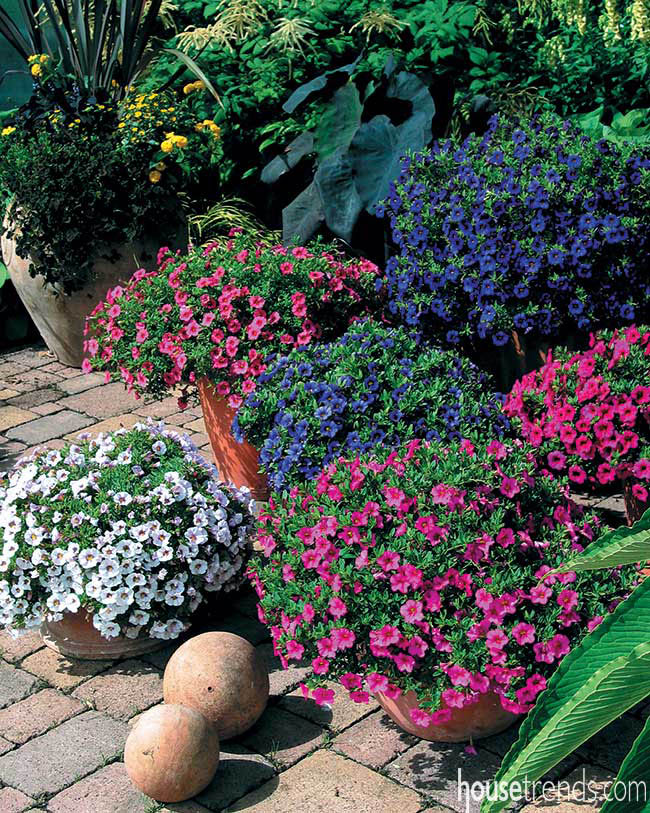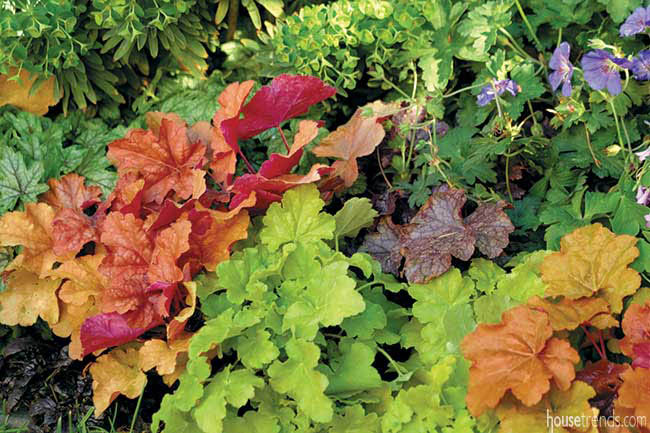Just as with fashions and home furnishings, there are trends in garden plants. Some are as
sizzling as a red-hot poker plant, while others seem as cold as a cement garden gnome in the shade—decorative, certainly, but not exactly “hip” or “happening.”
Cottage gardening used to be the hot ticket design style, but lately tropical gardens have been in the news instead. Annual plants used to be disdained by gardeners who favored the more fashionable perennials; now annuals are back in vogue. Some of today’s trendy plants are new; others have been around a while and have proven to be garden-worthy.
Why do some plants, flower colors and garden styles seem to come and go, while others become classics? We may never know. But we can take a look at some plants and plant trends that are “in” right now and wager on which might endure for the long run.
1) Vertical gardening
Why? Trellises and arbors, trailers and climbers add a third dimension to the landscape.
The plant: Clematis is a favorite vine that grandmother might have grown. A new twist is the Raymond Evison Patio Clematis Collection of compact vines, perfected for pot culture. They grow 3 to 4 feet tall, covered entirely with richly hued flowers to create a tower of color from spring through fall. These clematis plants have incredible vigor and disease resistance. Plant them in a sunny location.
Also try: Annual hyacinth bean, morning glory or moonflower vines.
2) Tropical plants
Why? Big bold flowers and foliage give lots of color and show in the heat of summer.
The plant: Cannas can’t be beat for injecting a tropical flavor into the garden. The dramatic 6-foot-tall stalks of green and yellow striped leaves on Canna ‘Bengal Tiger’ have a brilliant maroon leaf margin and are topped in summer with gaudy orange flowers that are as flamboyant as the plant’s namesake. Cannas do best when grown in full sun to part shade in a rich moist soil.
Also try: Calla lilies, caladium, banana, hibiscus and palm trees.
3) Romantic gardens
Why? In fashion, home design and gardening, romanticism and glamour are back in a big way.
The plant: Hydrangea ‘Limelight.’ This shrub has exceptional bright green blooms from mid-summer till autumn when the blooms change color to a rich deep pink. The autumn display of green and pink blooms on the same plant is breathtaking! The color blends wonderfully with all other colors in the landscape and looks magnificent and lush in bouquets, either fresh or dried. How romantic is that? It’s easy to grow, begins flowering in late July or early August and can reach 6 to 8 feet high. Plant it in full sun to light shade.
Also try: Flower Carpet roses and ‘The Fairy’ rose.
4) Fancy foliage
Why? Flowers come and go, but colorful foliage looks great all season long.
Plants to try: Coleus is the king of fancy foliage. This is not the timid little shade lover of the past. New coleus varieties come in sun-loving versions, too. Tall. Short. Large leaved or small. Ruffled, velvety or smooth. Burgundy, chartreuse, hot pink, dark purple—the palette is endless. Use these brilliant new coleus plants in hanging baskets, mixed containers, borders or beds.
Among woody choices, the ninebark shrub Physocarpus ‘Summer Wine’ has lustrous, deeply cut dark crimson leaves that add color and vibrancy to any garden. The wine-colored foliage looks outstanding next to yellow and bright green plants or against any light-colored background. As a bonus, it blooms with clusters of white button flowers in spring. ‘Summer Wine’ grows 4 to 6 feet high and wide and prefers full sun.
Also try: Fancy leaved hosta or Tiarella for shade.
5) Non-stop blooms
Why? Why not! Continuous bloom in annuals is expected, but in shrubs it’s a bonus.
Plants to try: Rosa ‘Knock Out.’ Numerous non-stop, fluorescent red flowers adorn this 3- to 4-foot shrub rose. It sports mossy green leaves with blue hues that are disease resistant and drought tolerant. The newer Pink Knock Out rose has a potent pink bloom. Neither requires deadheading; both bloom from early spring until the first hard frost in the fall. Plant them anywhere that gets five or more hours of direct sunlight each day.
Butterfly bush starts blooming in mid-summer and doesn’t quit till frost. There is a new English Butterfly Series out in which plants are extra bushy, reaching 4 to 5 feet and loaded with colorful flowers that butterflies and hummingbirds will swarm. Grow it in mostly sun and well-drained soil, in the landscape or a container.
6) The new annuals
Why? Outstanding new easy-care varieties are making these the logical choice of both beginner and expert gardeners.
Plants to try: Angelonias are closely related to snapdragons, but unlike snapdragons, they are extremely heat tolerant and bloom all summer long. Angelface Angelonias are a winner in sunny borders and container gardens with 12- to 18-inch-tall spikes of flowers. The Angelface series includes blue, white and blue bicolor flowers. They are also great for making bouquets.
Calibrachoa, also called Million Bells or Superbells, are a fabulous trailing plant for containers and landscapes. Prolific, non-stop blooms of velvety flowers come in a variety of unique colors. Easy care features like disease resistance and heat tolerance have made them a favorite of gardeners.
Also try: New Guinea impatiens, Wave petunias, scae-vola, Patriot lantana, ‘Star White’ zinnia and sweet potato vine.
7) Heuchera
Why? Prized primarily for their scalloped, textured and vividly colored foliage, Heuchera have replaced Hosta as the perennial plant collector’s plant craving.
The plant: Plant breeders have been flooding the market with lots of fine Heuchera, or coral bell, cultivars for the past few years, so it’s worth a trip to some plant nurseries to check them out. New this year is the Dolce Heuchera series: ‘Creme Brule,’ ‘Key Lime Pie’ and ‘Peach Melba.’ Most Heuchera are easy to grow, disease resistant, drought tolerant, pest-free and thrive in either sun or shade.
Also try: Lenten rose or Hellebore species—the next wave on the plant collector’s horizon.
8) Container gardening
Why? The love for container gardening just keeps on growing, and home gardeners are really crazy about the new lightweight, giant pots.
The plants: Consider growing any—or all—of the plants mentioned in this article in a container. The trend is towards mixed containers combining tropical plants, annuals, perennials and shrubs. Anything goes, as long as the water and light requirements of the plants are compat-ible. Large containers have more visual impact and require less frequent watering, so this is a great direction to move in—the bigger, the better!











